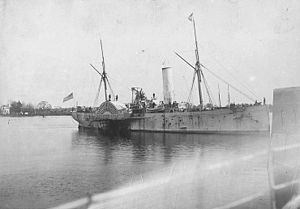USS Fort Jackson (1862)
 |
|
| History | |
|---|---|
| Name: | USS Fort Jackson |
| Launched: | 1862 |
| Acquired: | by purchase, 20 July 1863 |
| Commissioned: | 18 August 1863 |
| Decommissioned: | 7 August 1865 |
| Fate: | Sold, 27 September 1865 |
| General characteristics | |
| Type: | Sidewheel steamer |
| Displacement: | 1,850 long tons (1,880 t) |
| Length: | 250 ft (76 m) |
| Beam: | 38 ft 6 in (11.73 m) |
| Draft: | 18 ft (5.5 m) |
| Propulsion: | Steam engine |
| Speed: | 14 knots (26 km/h; 16 mph) |
| Armament: |
|
USS Fort Jackson was a wooden side wheel steamer in the United States Navy during the American Civil War.
Fort Jackson was in New York in 1862, formerly named Kentucky and Union, was purchased by Rear Admiral Hiram Paulding for the Navy from C. W. Vanderbilt on 20 July 1863 and placed in commission on 18 August 1863, Captain Henry A. Walke in command.
On 2 September she departed New York for Fort Monroe where she joined with steamer Connecticut in intercepting a British arms shipment from Bermuda to Wilmington, North Carolina. While sailing from Bermuda on 16 September a boiler burned out and forced her to repair at New York.
In December 1863 Fort Jackson was assigned to the North Atlantic Blockading Squadron to cruise off the Western Bar, Cape Fear, and the following month helped in destroying the grounded blockade runner Bendigo at Folly Inlet. In April, Captain Benjamin F. Sands, her commanding officer, organized a boat expedition in which her crew crossed the bar to Masonboro Sound and destroyed valuable State salt works, and seized a number of prisoners.
The steamer captured the blockade runner Thistle in June and took the runner Boston as prize during the next month. The success of her voyage was heightened when in the same period she plucked drifting cotton bales and bags from the sea and sent them to Philadelphia for adjudication.
During October she was attached to the 2nd Division North Atlantic Blockading Squadron and on 21 October captured CSS Wando attempting to run through with a cargo of cotton.
...
Wikipedia
